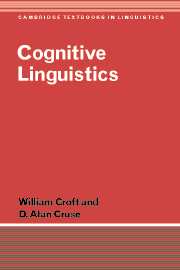Book contents
- Frontmatter
- Contents
- Figures
- Tables
- Preface
- 1 Introduction: what is cognitive linguistics?
- A conceptual approach to linguistic analysis
- 2 Frames, domains, spaces : the organization of conceptual structure
- 3 Conceptualization and construal operations
- 4 Categories, concepts and meanings
- Cognitive approaches to lexical semantics
- Cognitive approaches to grammatical form
- References
- Index
- Index
4 - Categories, concepts and meanings
Published online by Cambridge University Press: 05 June 2012
- Frontmatter
- Contents
- Figures
- Tables
- Preface
- 1 Introduction: what is cognitive linguistics?
- A conceptual approach to linguistic analysis
- 2 Frames, domains, spaces : the organization of conceptual structure
- 3 Conceptualization and construal operations
- 4 Categories, concepts and meanings
- Cognitive approaches to lexical semantics
- Cognitive approaches to grammatical form
- References
- Index
- Index
Summary
Introduction
The act of categorization is one of the most basic human cognitive activities. Categorization involves the apprehension of some individual entity, some particular of experience, as an instance of something conceived more abstractly that also encompasses other actual and potential instantiations. For instance, a specific animal can be construed as an instantiation of the species DOG, a specific patch of color as a manifestation of the property RED, and so on. We shall call this abstract mental construct a conceptual category. Conceptual categories can be regarded as cognitive tools, and are usually credited with a number of general functions:
Learning. Experiences never recur exactly: our ability to learn from past experience would be severely impaired if we could not relate the present to similar aspects of past experience, that is, by putting them into the same conceptual categories.
Planning. The formulation of goals and plans to achieve them also requires knowledge to be disassociated from individuals and packaged into concepts characterizing categories of entities.
Communication. Language works in terms of generalities, that is, in terms of categories. Any linguistic expression, however detailed, in the end represents only a category of referents.
Economy. Knowledge does not (all) need to be related to individual members: a significant amount can be stored in relation to groups of individuals. New knowledge gained on the basis of interaction with one or more individuals can be easily generalized to other members of category. Conversely, knowing, on the basis of a limited number of criteria, that an individual belongs to a particular category, can give access to a much wider range of information about that individual.
- Type
- Chapter
- Information
- Cognitive Linguistics , pp. 74 - 106Publisher: Cambridge University PressPrint publication year: 2004

